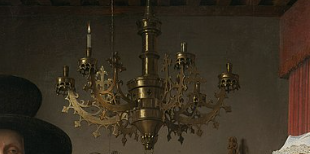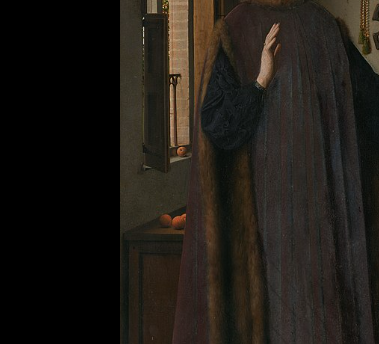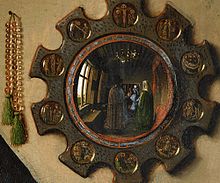The Arnolfini Portrait
.jpg)
One of my friends showed me this image a little bit ago, and it's been on my mind ever since, it just won't leave. There's just... something about it. I remember learning about it a while back, in high school AP Euro class. I was taught about it as a commemoration and witness of a wedding, but my friend showed me a separate version of it, which I can't shake now, the proposal that it is more a funerary scene, rather than a marital scene.
It's proposed that it's a funerary scene for a rash of reasons. The first is that, if it represents who it is supposed to represent, at least by modern theorists, than the 1434, which is inscribed above the mirror (Jan Van Eyck was here. 1434), is a year after the wife died during childbirth. This can then be supported by several other things.
The first is, notice the candles on the chandelier, and how they're turned on on the man's side, and off on the woman's. The fact that they're depicted as on in the first place is pretty surprising, seeing as there is clearly ample light already present in the room.

Additionally, notice the deadness in the man's eyes, and the look of yearning in the woman's. She seems to be almost pensive about something, perhaps leaving him, while his eyebrows are crossed in seeming consternation, giving her a slight sideye, possibly trying not to react to much, to remain stoic, in the face of his late wife, trying to avoid her penetrating look.

The next reason for this theory, that I have at least, is the position of the hands. Notice how his is put up, parallel to her, sort of shooing her away, in a sense, setting up a barrier, possibly similar to the one by his side eye previously detailed. Contrast this to her hand, positioned in such a way to slip out, almost as if she is going, or has gone, away. Her other hand is spent holding up her dress, as was the fashion at the time, rather than shooing him away, or trying to connect with him in another way, which appears to be a recurrent theme in this image.

Another reason I have, which I only really noticed while writing this, was the positioning of the oranges haphazardously. At this time, oranges were a luxury item, so not keeping them orderly is a sign of disarray, potentially a form of disarray happening because of the passing of a member of the household, the one who's responsibility it is to keep everything orderly (as a housewife).

The final reason I have, is in the minor images around the mirror. These are images from the Passion of Christ, and all the images on the woman's side are of the death and resurrection of Jesus, whilst the images on the man's side are of His life.

Additionally, there are plenty of other weird inconsistencies and whatnot, which I implore you, the reader to further look into on your own, with 2 I can quickly point out being the wearing of winter clothes in spring or summer (as is evidenced by the blossoming tree outside), and the size of the mirror being bigger than anything capable of being made at the time.
This post part of the AgoraRoad Travelogue